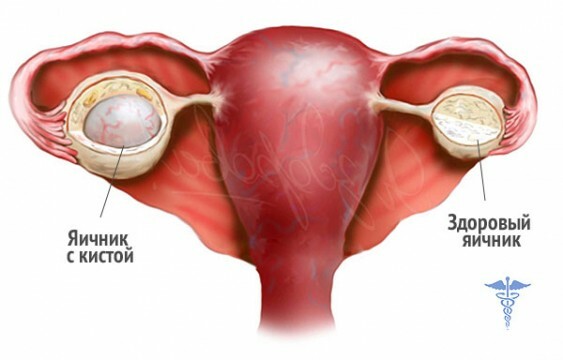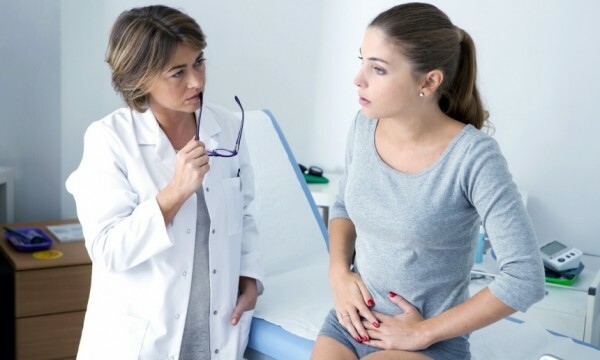Ovaries are the most important organs of the female reproductive system. They develop eggs, which later connect with spermatozoa and give rise to a new life. But unfortunately, like other organs, the ovaries are susceptible to various diseases. The most common of these is the cyst of the right ovary.
Cyst of the right ovary is a thin-walled cavity that is small in size and filled with liquid contents. Cyst develops usually from a follicle located inside the right ovary. Many cysts are not accompanied by changes in health and unpleasant symptoms, do not require treatment and disappear on their own, therefore, do not pose a threat to a woman's health. In order to better understand the essence of this disease, let us dwell in more detail on some points.
Causes of

The causes of the cyst( functional, endometrioid, yellow, dermoid) have not been fully clarified, but a number of factors contributing to the development of this disease can be identified:
- changes in the process of maturation of the follicle for unknown reasons;
- the onset of menstruation before 11 years;
- previous abortions;
- disruption of the endocrine system;
- presence of previously identified cysts on the ovaries;
- irregular menstrual cycle;
- use of drugs to treat breast cancer in women.
To reduce the risk of developing cystic ovarian changes, you can use hormonal oral contraceptives , as they stop the production of eggs.
Symptoms of
Most often, the cyst of the right ovary shows no symptoms, it is often found only when ultrasound of the pelvic organs. But sometimes a woman may be disturbed by changes in her state of health and such symptoms:
- pain in the lower abdomen, periodically sharp enough, with an unknown cause;
- feeling of heaviness and pressure in the pelvic region;
- failure of the monthly cycle;
- pain during menstruation;
- pain in the vagina, accompanied by bloody discharge;
- unpleasant symptoms in the act of bowel movements or urination;
- arising emetic retching after sexual intimacy or intense physical exertion.
The reason for immediate medical attention is the situation when the following symptoms are added to the listed symptoms:
- excessively abundant discharge with monthly;
- sudden body temperature jump above 38 degrees, for no reason;
- frequent dizziness and weakness;
- strengthening of hair growth by male type, coarsening of the voice( hormonal changes);
- abdomen increases in volume;
- profuse urination, combined with a strong thirst;
- sudden change in weight;
- appearance of compaction in the abdominal cavity;
- blood pressure jumps.
Classification

The cyst is divided into 5 types:
- Follicular - is formed in the case of not onset of ovulation. This type of cyst often appears in young girls during puberty. Usually not accompanied by unpleasant symptoms.
- Yellow body cyst. It appears at the moment of the release of the egg from the follicle, after which the follicle is transformed into a yellow body, which gradually dissolves. However, sometimes a failure occurs, and the yellow body continues to grow inside the ovary, filling with fluid or blood.
- Paraovarial - is a chamber with thin walls, quite a large size, arises and grows in the area of the mesentery of the fallopian tube from the epididymis. The most common symptoms are found in women of childbearing age over 30 years. Given its characteristics, this cyst is characterized by slow growth and low mobility.
- Dermoid - is classified as one of the varieties of benign tumors. Can contain the sebaceous glands, hair and hair follicles, which are in a slimey mass and covered with a capsule with thick walls. In some cases, the cause of it is a traumatic injury. Has a high probability of inflammation. Symptoms are observed in girls during puberty and in young women.
- Endometrioid - the causes of its occurrence are cases where the tissue of the mucosa lining the uterus inside( endometrium), begins for an unknown reason to grow in the ovary. In this form, cysts in most cases are also affected by neighboring internal organs( intestine, ureter, bladder). Usually, they do not cause any unpleasant symptoms.
Separately, we should focus on the formation of of the ovarian cyst. Unlike cysts, cystoma is a true tumor of the ovaries and is characterized by the presence of a cavity( often multi-chamber) filled with liquid contents. Increases in size not only due to the accumulation of fluid inside the cavity, but also due to the division of cells forming it. It can be formed directly from the ovary( primary), or may be formed as a result of metastases( secondary).Also, cystomas can be proliferating, benign, malignant. Ovarian cyst is only treatable by surgery.
Diagnostic methods
In the diagnosis of this disease, the following methods can be used:
- examination of a gynecologist, which allows to determine the increase in appendages or tenderness in the pelvic region;
- carrying out ultrasound, which is the most informative and frequently used method;
- magnetic resonance imaging, sometimes assigned to confirm the result of ultrasound diagnosis;
- computed tomography;
- the puncture of the posterior vault of the vagina;
- laparoscopic examination of the cyst of the right ovary, conducted under general anesthesia;
- blood test for general indicators and oncomarkers;
- test to determine pregnancy, which allows to exclude ectopic development of the fetus.
Treatment of

Quite often the cyst disappears on its own and does not need treatment. For example, if there is such a neoplasm as the functional cyst of the left ovary , medication is prescribed only if it is accompanied by unpleasant symptoms, tends to grow rapidly or does not resolve for more than three months .If you have pain, before contacting your doctor, you must limit any kind of physical activity in order to reduce the risk of torsion or rupture of the cyst( functional, endometrioid, yellow, dermoid), and take painkillers.
The decision on the method of treatment( including herbs) of one or another type of cyst of the right ovary is taken by the doctor on the basis of the complex of examination performed. Rid the patient of this disease can be using medication or with the help of surgery. Let us dwell in more detail on each of the methods.
Medication for right ovarian cysts and herbs treatment
The following drugs
- hormonal oral contraceptives , which help regulate the menstrual cycle, stop the maturation of follicles, stop the growth of an already existing cyst;
- Anti-inflammatory drugs based on ibuprofen can help relieve pain symptoms in the pelvic region. According to a prescription written by a doctor, you can buy more powerful painkillers in the pharmacy, helping to alleviate even the most intense pain;
- herbal medicine ( using herbs).
Surgical treatment methods( removal)
- Laparoscopic surgery. During the operation, the doctor injects gas into the abdominal cavity of the patient, then makes a small incision. It introduces a laparoscope, through which the precise location of the cyst is determined through the sight, after which it is removed or sampled;
- Removal with laparotomy. This type of surgical intervention is more traumatic for the patient, since removal of the cyst is performed under general anesthesia through a full incision of the abdominal wall.
Methods for the removal of the cyst
Methods for the removal of the cyst( functional, endometrioid, yellow body, dermoid):
- Kystectomy - removal of the cyst, allowing to preserve healthy ovarian tissue. It is carried out by a method of carefully hatching a capsule containing a cyst( functional, endometrioid, dermoid) without affecting the healthy tissue. This method allows you to maintain the integrity of the ovary, and it is able to continue to perform its functions. But it should be remembered that the possibility of his forthcoming full-fledged work will depend on how large the cyst was and how much healthy tissue remained.
- Conducting wedge resection of the right ovary .The cyst is excised from the ovary in a wedge-shaped manner, after which it is closed with self-converging threads. After such an intervention, much less healthy tissue remains than with the previous method.
- Adnexectomy of , when the uterine appendages are completely removed during surgery, or ovariectomy, at which the right ovary is removed.
- Biopsy method - is performed more for diagnostic purposes when there is a suspicion of malignant formation. In this case, the tissue for both the left and right ovaries is taken for laboratory testing.
In detecting such varieties of the cyst as dermoid, mucinous or endometrioid, accompanied by unpleasant symptoms, only surgical treatment methods( removal) are shown.
Recovery after surgical intervention
After removal of cystic formation, before leaving the hospital, the patient usually receives the following recommendations from the doctor:
- abstinence for 30 days after cyst removal( functional, endometrioid, dermoid);
- do not take a bath for two weeks after surgery;
- seam treatment with disinfectant;
- Avoid alcohol and fatty foods during the first month after surgery;
- does not plan a pregnancy for at least the first 3 months after surgery;
- regular visit to the gynecologist to monitor the recovery process.
During the rehabilitation period after the surgical intervention to remove the cyst, in addition to complying with the general recommendations of the doctor, , you can also take advantage of traditional medicine .Methods such as herbal treatment can be used for general recovery of the body and how to prevent relapse. Just like pharmacy products, herbs are taken in courses with a total duration of no more than 3 months.



